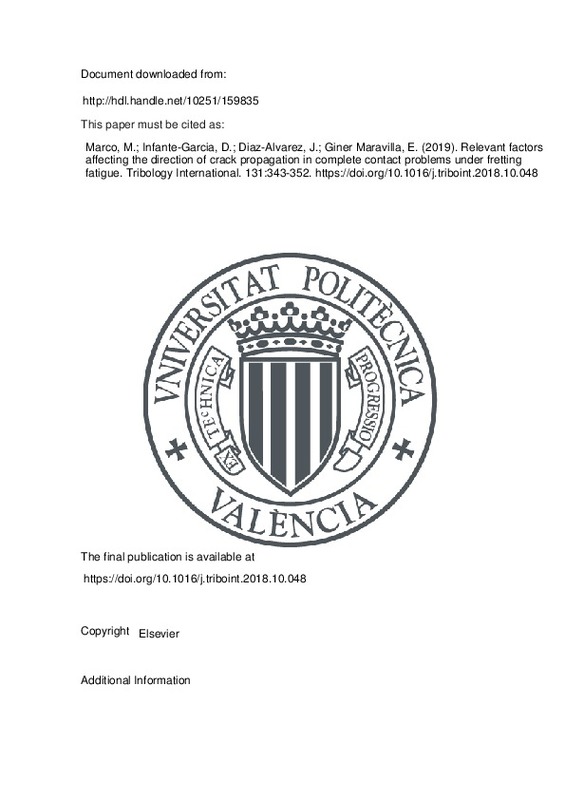Hills, D. A., & Nowell, D. (1994). Mechanics of Fretting Fatique. Solid Mechanics and Its Applications. doi:10.1007/978-94-015-8281-0
Giannakopoulos, Suresh, & Chenut. (2000). Similarities of stress concentrations in contact at round punches and fatigue at notches: implications to fretting fatigue crack initiation. Fatigue <html_ent glyph=«@amp;» ascii=«&»/> Fracture of Engineering Materials and Structures, 23(7), 561-571. doi:10.1046/j.1460-2695.2000.00306.x
CIAVARELLA, M. (2003). A ‘crack‐like’ notch analogue for a safe‐life fretting fatigue design methodology. Fatigue & Fracture of Engineering Materials & Structures, 26(12), 1159-1170. doi:10.1046/j.1460-2695.2003.00721.x
[+]
Hills, D. A., & Nowell, D. (1994). Mechanics of Fretting Fatique. Solid Mechanics and Its Applications. doi:10.1007/978-94-015-8281-0
Giannakopoulos, Suresh, & Chenut. (2000). Similarities of stress concentrations in contact at round punches and fatigue at notches: implications to fretting fatigue crack initiation. Fatigue <html_ent glyph=«@amp;» ascii=«&»/> Fracture of Engineering Materials and Structures, 23(7), 561-571. doi:10.1046/j.1460-2695.2000.00306.x
CIAVARELLA, M. (2003). A ‘crack‐like’ notch analogue for a safe‐life fretting fatigue design methodology. Fatigue & Fracture of Engineering Materials & Structures, 26(12), 1159-1170. doi:10.1046/j.1460-2695.2003.00721.x
Giner, E., Sukumar, N., Denia, F. D., & Fuenmayor, F. J. (2008). Extended finite element method for fretting fatigue crack propagation. International Journal of Solids and Structures, 45(22-23), 5675-5687. doi:10.1016/j.ijsolstr.2008.06.009
Giner, E., Tur, M., Vercher, A., & Fuenmayor, F. J. (2009). Numerical modelling of crack–contact interaction in 2D incomplete fretting contacts using X-FEM. Tribology International, 42(9), 1269-1275. doi:10.1016/j.triboint.2009.04.003
Giner, E., Navarro, C., Sabsabi, M., Tur, M., Domínguez, J., & Fuenmayor, F. J. (2011). Fretting fatigue life prediction using the extended finite element method. International Journal of Mechanical Sciences, 53(3), 217-225. doi:10.1016/j.ijmecsci.2011.01.002
Martínez, J. C., Vanegas Useche, L. V., & Wahab, M. A. (2017). Numerical prediction of fretting fatigue crack trajectory in a railway axle using XFEM. International Journal of Fatigue, 100, 32-49. doi:10.1016/j.ijfatigue.2017.03.009
Pereira, K., & Abdel Wahab, M. (2017). Fretting fatigue crack propagation lifetime prediction in cylindrical contact using an extended MTS criterion for non-proportional loading. Tribology International, 115, 525-534. doi:10.1016/j.triboint.2017.06.026
Sabsabi, M., Giner, E., & Fuenmayor, F. J. (2011). Experimental fatigue testing of a fretting complete contact and numerical life correlation using X-FEM. International Journal of Fatigue, 33(6), 811-822. doi:10.1016/j.ijfatigue.2010.12.012
Sunde, S. L., Berto, F., & Haugen, B. (2018). Predicting fretting fatigue in engineering design. International Journal of Fatigue, 117, 314-326. doi:10.1016/j.ijfatigue.2018.08.028
NAVARRO, C., GARCIA, M., & DOMINGUEZ, J. (2003). A procedure for estimating the total life in fretting fatigue. Fatigue <html_ent glyph=«@amp;» ascii=«&»/> Fracture of Engineering Materials and Structures, 26(5), 459-468. doi:10.1046/j.1460-2695.2003.00647.x
Pereira, K., Bhatti, N., & Abdel Wahab, M. (2018). Prediction of fretting fatigue crack initiation location and direction using cohesive zone model. Tribology International, 127, 245-254. doi:10.1016/j.triboint.2018.05.038
Araújo, J. A., Almeida, G. M. J., Ferreira, J. L. A., da Silva, C. R. M., & Castro, F. C. (2017). Early cracking orientation under high stress gradients: The fretting case. International Journal of Fatigue, 100, 611-618. doi:10.1016/j.ijfatigue.2016.12.013
Giner, E., Sabsabi, M., Ródenas, J. J., & Javier Fuenmayor, F. (2014). Direction of crack propagation in a complete contact fretting-fatigue problem. International Journal of Fatigue, 58, 172-180. doi:10.1016/j.ijfatigue.2013.03.001
Mo�s, N., Dolbow, J., & Belytschko, T. (1999). A finite element method for crack growth without remeshing. International Journal for Numerical Methods in Engineering, 46(1), 131-150. doi:10.1002/(sici)1097-0207(19990910)46:1<131::aid-nme726>3.0.co;2-j
Giner, E., Sukumar, N., Tarancón, J. E., & Fuenmayor, F. J. (2009). An Abaqus implementation of the extended finite element method. Engineering Fracture Mechanics, 76(3), 347-368. doi:10.1016/j.engfracmech.2008.10.015
Hattori, T., Nakamura, M., & Watanabe, T. (2003). Simulation of fretting-fatigue life by using stress-singularity parameters and fracture mechanics. Tribology International, 36(2), 87-97. doi:10.1016/s0301-679x(02)00141-x
Erdogan, F., & Sih, G. C. (1963). On the Crack Extension in Plates Under Plane Loading and Transverse Shear. Journal of Basic Engineering, 85(4), 519-525. doi:10.1115/1.3656897
Fadag, H. A., Mall, S., & Jain, V. K. (2008). A finite element analysis of fretting fatigue crack growth behavior in Ti–6Al–4V. Engineering Fracture Mechanics, 75(6), 1384-1399. doi:10.1016/j.engfracmech.2007.07.003
Gol’dstein, R. V., & Salganik, R. L. (1974). Brittle fracture of solids with arbitrary cracks. International Journal of Fracture, 10(4), 507-523. doi:10.1007/bf00155254
Cotterell, B., & Rice, J. R. (1980). Slightly curved or kinked cracks. International Journal of Fracture, 16(2), 155-169. doi:10.1007/bf00012619
Nuismer, R. J. (1975). An energy release rate criterion for mixed mode fracture. International Journal of Fracture, 11(2), 245-250. doi:10.1007/bf00038891
Giner, E., Sabsabi, M., & Fuenmayor, F. J. (2011). Calculation of KII in crack face contacts using X-FEM. Application to fretting fatigue. Engineering Fracture Mechanics, 78(2), 428-445. doi:10.1016/j.engfracmech.2010.11.002
Ribeaucourt, R., Baietto-Dubourg, M.-C., & Gravouil, A. (2007). A new fatigue frictional contact crack propagation model with the coupled X-FEM/LATIN method. Computer Methods in Applied Mechanics and Engineering, 196(33-34), 3230-3247. doi:10.1016/j.cma.2007.03.004
McDiarmid, D. L. (1994). A SHEAR STRESS BASED CRITICAL-PLANE CRITERION OF MULTIAXIAL FATIGUE FAILURE FOR DESIGN AND LIFE PREDICTION. Fatigue & Fracture of Engineering Materials and Structures, 17(12), 1475-1484. doi:10.1111/j.1460-2695.1994.tb00789.x
Fatemi, A., & Socie, D. F. (1988). A CRITICAL PLANE APPROACH TO MULTIAXIAL FATIGUE DAMAGE INCLUDING OUT-OF-PHASE LOADING. Fatigue & Fracture of Engineering Materials and Structures, 11(3), 149-165. doi:10.1111/j.1460-2695.1988.tb01169.x
Giner, E., Tur, M., Tarancón, J. E., & Fuenmayor, F. J. (2009). Crack face contact in X-FEM using a segment-to-segment approach. International Journal for Numerical Methods in Engineering, 82(11), 1424-1449. doi:10.1002/nme.2813
[-]







![[Cerrado]](/themes/UPV/images/candado.png)


